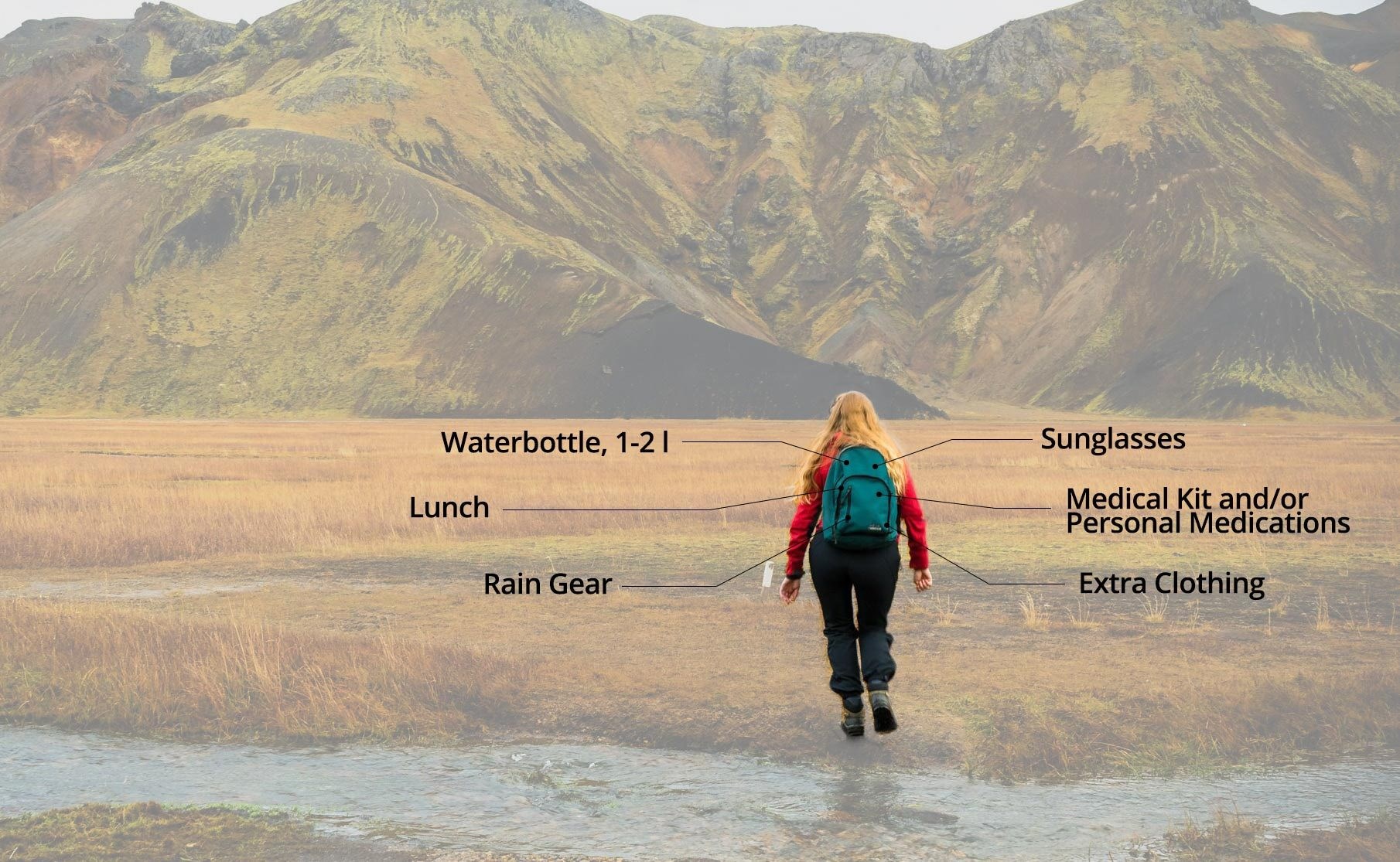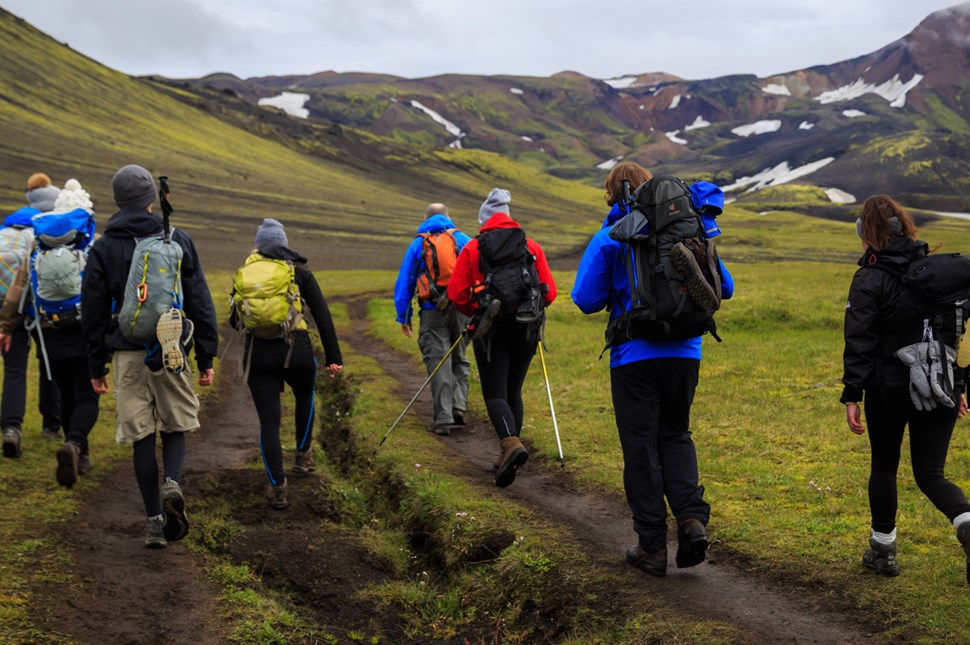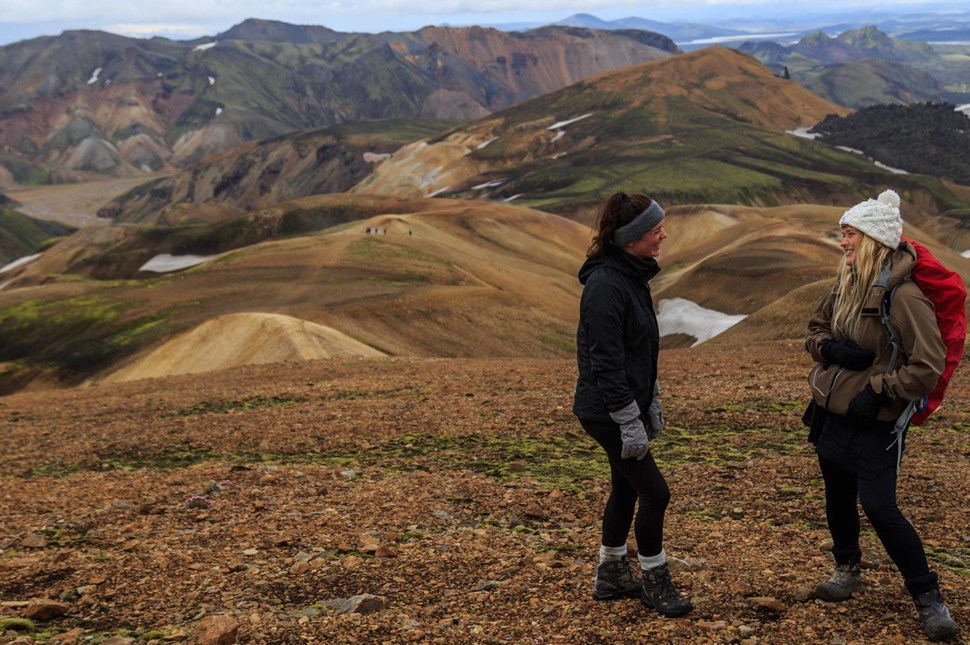Iceland is open for travel. Check volcano updates here
Iceland is home to spectacular hiking trails and trekking routes like no other. You can climb active volcanoes, explore black pebbly beaches, discover the crevices of a glacier, and ramble through the remote but charming wilderness. However, preparation is key to ensuring you are comfortable and safe throughout these exhilarating but sometimes vigorous activities. We’ve put together clothing guides and equipment lists that will help you get ready for your single-day hike or multi-day trek in Iceland.
When going hiking and trekking, regardless of how many days you are going for, it is always good to plan your packing in advance. It’s important to bring all the things you need but not all the things you want, as unnecessary weight can hold you back and make the route far more difficult.
One of the main things to start with when preparing for a hike or trek in Iceland is to have a “packing system.” You should think about what you’ll be putting in your main bag (luggage) and what you will be needing for your hike or trek.
For most of our tours, you need to bring a small backpack, ideally 25-40 L, that you will carry during the day. In this backpack, you should pack your lunch, water bottle, rain gear, and other items you might need for the day, such as medication, extra clothing, sunglasses, etc. For some of our tours, you will need to carry with you a pair of river-crossing shoes. In general, it is always good to try to keep your pack as light as possible and only bring the necessary items.

For our longer trekking tours, where you could be hiking for up to 8 days, you will have to bring more necessary equipment and clothing. Depending on the tour, your main luggage will either be staying in one hut, being transported between huts/campsites by a support vehicle, or, in some tours, you will have to carry it along with you.
Space is limited, so we would appreciate it if you keep your luggage light and in a soft bag rather than a suitcase. This luggage, like you, will sometimes need to cross rivers, so we recommend waterproof duffel bags to keep your belongings dry from splashes. A 70-80 L bag should be more than enough. If you have extra luggage that you would like to leave, we recommend storing luggage at the BSI Bus terminal (fees apply) or another luggage storage space in Reykjavik.
The items needed for your trip will depend greatly on how long you are touring for, however, this list will ensure that nothing is left behind that you’ll miss.

Dressing for Iceland is an adventure on its own. You should keep the following tips in mind and make sure your clothing meets the following criteria:
Unfortunately, no single item of clothing exists that fulfills all of the demands listed above. Therefore, our challenge is to find the most efficient selection of clothing that combines all of these features, maximizing performance while minimizing space and weight. Our solution lies in the layers.

We have learned from experience that a 3-layer structure is the best way to go. Each layer has its own specialized role and purpose. A simple layering system consists of a transfer layer (base layer) next to your skin, adjustable insulating layers, and an outer shell to protect you from water and the wind. Rather than a few warm and bulky garments, we recommend selecting lighter and more versatile pieces that can be worn in various combinations to manage better the wide range of sometimes unpredictable conditions that you will encounter in Iceland.
Worn directly against the skin, this layer is designed to move or “wick” perspiration away from your body, thus keeping you dry from the inside. When this layer gets wet (from sweating), it is important that it maintains its insulating value while minimizing absorption. For this reason, it is generally made of wool or synthetic materials and never of cotton. Since this layer is directly in contact with your skin, comfort is also important, so consider something that avoids rubbing in sensitive places. Consider packing an extra set so that you can use one for hiking and the other for comfortable evening relaxation and sleeping.

Base layers suitable for hiking in Iceland including leggings and socks.
This is the most versatile of all layers and will be determined by activity levels as well as the outside environment. The purpose of the insulating layer is to manage body heat appropriately. Light and medium-weight fleece jackets are ideal during the day when activity levels are higher and daytime temperatures are warmer. Hiking pants should be made of light, strong, and quick-drying fabrics. Fleece pants or expedition weight underwear (that's suited for cold weather) also work well. Again, garments made of cotton, such as jeans, are a poor option as they tend to absorb moisture. On cold days and during the evenings, two insulating layers work well together to provide extra warmth. It's also convenient to bring a jacket that's been made from thermal insulation material that you can put on during breaks or in the evening.

Insulating layer clothing should be made from light, strong, quick-drying fabrics.
This layer is mainly meant to protect you from the two most threatening elements: wind and rain. The other critical function of the outer shell is the ability to allow moisture to escape or “breathe” to prevent you from getting wet from inside due to sweat. Additional features such as hoods and zip ventilation systems allow for more precise adjustments and help to maximize warmth and comfort outdoors, although they are not essential. It is very important that jackets and pants be waterproof, windproof, and breathable. Keep in mind that favorable weather conditions may often be such that the use of the outer shell is not needed. Nevertheless, it is always wise to have this layer easily accessible, as conditions can change quickly.

Outer layer clothing suitable for hiking in Iceland including hiking boots and waterproof pants.
Once you have all your layers on, other important add-ons to think about are shoes and all accessories that will keep you warm and cozy and finish your ensemble.
Selecting the most suitable shoes for your hiking trip in Iceland is extremely important, and with so much choice it can be difficult to know where to begin. They need to provide comfort, support, and stability, and they must keep your feet dry. The key features to look for are:
Some of the most recommended brands include Columbia, Scarpa, and Salomon. A great choice of boot that is suitable for both men and women is the Scarpa Zodiac Plus GTX, which is praised for its stability and shock absorption. Other favorites are the Colombia Men’s Newton Ridge Plus II and the Lowa Women’s Renegade GTX Mid W’s.
Quality hiking boots are not cheap, but the investment is worthwhile when it comes to ensuring your feet are well-equipped to handle the many miles you will cover. Together with your main hiking boots, have an extra pair of shoes you can change into after a day of being on your feet. River crossing shoes are also needed for all Laugavegur trekking tours. To make crossings safely, you will need a separate pair of shoes for stream crossings. Quick-drying trail runners, sandals (with straps!), old sneakers, or neoprene booties are the best options.
Together with high-quality footwear, you’ll also need:

Before preparing for your trip, you should decide if you’re going to hike or trek. If you’re not sure which one of the two to choose, the best way to decide is by comparing hiking vs trekking in Iceland. Another thing to consider is whether and what kind of tour you should book. We have divided our hiking and trekking tours into 3 categories, hiking tours, trekking tours and Laugavegur trek. All to make it easier for you to find the perfect Icelandic adventure.
Hiking is a long walk that usually takes no longer than one day. So if you wish to explore parts of Iceland by foot in a day and then come back to have a good night’s rest, this activity is more than suitable for you. In Iceland, you’ll find day hikes with different locations and different levels.
If you are looking for a longer adventure, trekking is your activity. Depending on your abilities and the time you have in Iceland, you can find trekking tours with different locations and lengths. Just keep in mind that trekking is considered a strenuous walk that starts from one day and can take up to weeks. Trekking also means that you’ll have to sleep surrounded by nature. That’s why, in some of our tours, you’ll be camping in tents, and in others, you’ll experience stayovers in huts.
If you’re ready for an unforgettable adventure that includes hiking or trekking, one of the main spots you have to visit is Landmannalaugar. Its most popular trekking trail is called Laugavegur. Many trekkers enjoy this area because of its extraordinary landscapes and unseen terrains. If you’re already hooked, check out an extensive Laugavegur trail packing list to know how to prepare for this experience best.